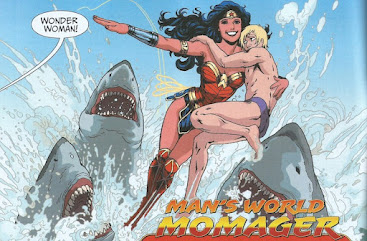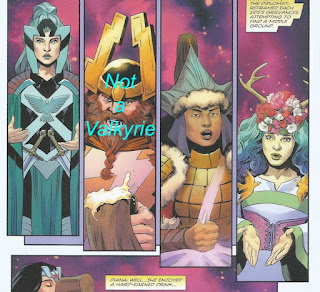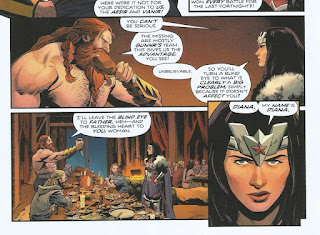Pick of the Brown Bag
August 25, 2021
by
Ray Tate
Welcome to the newest Pick of the Brown Bag. I'm your comics guru, Ray Tate. For this posting, I take a tour of the new DC Wonder Woman title Sensational Wonder Woman. A play of words on Wonder Woman's original home.
Sensational Wonder Woman is ideal for somebody that doesn't want to subscribe to Wonder Woman and/or doesn't want to get involved in a story arc. This reader likes Wonder Woman, not necessarily her continuity, and the occasional good Wonder Woman adventure.
Sensational Wonder Woman consists of stand-alone Wonder Woman tales with differing writers and artists. Continuity is flexible, and so far DC published six issues. The first I reviewed in depth earlier.
The second issue of Sensational Wonder Woman by Andrea Shea pits Wonder Woman against frequent foil Artemis. It didn't start out that way. Wonder Woman answered an sos from Artemis. They nevertheless end up fighting in the gladiator pit on War World. How they reach this point offers a twist or two.
Even if you don't know what a War World is, you'll catch on quick. Older fans will be surprised at some of the new wrinkles in the shtick. Of course there's always the tried and trusted.
Master of War World, Mongul becomes involved in the duel, and there's much rejoicing when Wonder Woman and Artemis soon hand this perpetual loser his ass.
Mongul only had one moment of Bronze Age glory, which is one better than Kobra. In Alan Grant's and Dave Gibbons' "For the Man Who Has Everything," the feature of a Superman Annual, Mongul overcomes Superman with the Black Mercy and stands toe-to-toe against Wonder Woman.
If you gave Ally Babble an immersive hallucinogenic weed, he would have partially succeeded as well. Come to think of it. So would Kobra. I'm also pretty sure Wonder Woman had the sniffles that day.
The art of Sensational Wonder Woman by Bruno Redondo is absolutely mouth-watering. Dynamic anatomy in multiple clashes, and Redondo is equally adept at depicting the quieter moments.
In the third issue, Colleen Doran brings her skill for writing and art in a tale that depicts a kind of day in the life of Diana. First Wonder Woman explodes onto the scene.
The sharks are in fact Megs, which have somehow become the royal escorts of Themyscira. They also show up in the adventures of Young Diana in the backup feature of Wonder Woman. I don't recall them appearing anywhere in the Bronze Age, the television series or the films however. Oh, well. Not important.
After a meet and greet on the beach, a local blaze, not Johnny, quickly catches Diana's attention. During the focus on Wonder Woman, Doran reboots one of Wonder Woman's nineties cast members, depicted on the cover.
She looks quite different. So, this isn't a spoiler. I never had any affinity with the cast member. Still, Doran demonstrates the woman's worth and her sense of ethics in business. That puts on a different spin.
Doran's Wonder Woman gibes with the Lynda Carter version of the character. She's friendly, an idol to millions of people and casually powerful.
In the third issue's side B Alyssa Wong throws a "Museum Gala" with invitees Diana Prince and Bruce Wayne.
Mr. Freeze shows up, and Wonder Woman, who seldom needs to protect her secret identity, even when she had one, goes into action.
This story works through a combination of wit, the friendship between Diana and Bruce as well as the cartoony, energetic art of Eleonora Carlini. Colors by Enrica Eren Angiolini add pizzazz.
In the fourth issue Corrine Bechko opens her story with Diana attending a climate change conference. There she meets a woman who claims to be able to control the weather by moving the clouds to where they need to be.
Of course, this is a potty theory. Nevertheless, she makes it rain without placing a single bet on Draft Kings. Unfortunately the experiment gets out of hand, and Wonder Woman under the auspices of artist Dani finds herself battling her old enemy the Blue Snowman.
Nope. I never heard of this character before either. Can the wikipedia save us? Apparently so.
A secret villain pulls the Snowman's strings. This villain is well known to Wonder Woman fans. Bechko though in dialogue shorthand explains what you need to know. Even had you never read a single issue of Wonder Woman, you would still know what floats the boats of both foes.
With the fifth issue, Amy Chu teams up with Maria Laura Sanapo for a time-spanner that delves into Wonder Woman's World War II history as well as her current history.
This issue is a good example of how Sensational Wonder Woman doesn't follow the rules of continuity but looks at the historical canon.
Since the nineties DC Comics eschewed Wonder Woman's World War II history. George Perez reintroduced her as a contemporary character. Subsequent reboots followed suit.
Chu and Sanapo instead embrace Wonder Woman's immortality and present her as a Nazi fighter and an everlasting symbol of justice and feminism.
An elderly woman relates the story of her long friendship with Wonder Woman, but this history threatens her existence. Since nobody believes her. For the same reason, mad science in a comic book is just science, it will come to nobody's surprise that Katie speaks the truth.
Yes, Chu's story is predictable, but nobody wanted to see this sweet, old woman put out on the street because of a potentially hyperactive imagination. It would have been a disappointment had Wonder Woman not shown up, validated Katie's recollections and saved the day. This isn't a Black Label book.
Sina Grace in the most recent issue presents a collage of Wonder Woman continuity. Paul Pelletier is just the artist to illustrate this fun little villains team-up. First, Artemis leads the Amazons on an attack on Parliament.
The opening scene reflects the universally reviled mini-series Amazon Attacks. However, Diana knows something's up on page three.
It doesn't take six miserable issues to find out the gist of it all. Let me just say at this point. I love Paul Pelletier's, Norm Rapmund's and Adriano Lucas' art even when Pelletier is not having characters bash each other's heads in.
That moment of realistic body language is just beautiful. Enhanced by the subdued colors.
Diana's investigation leads her to Themyscira where she meets the first attacker from her Rogue's Gallery. I don't really count Artemis as a rogue. She's more of a hot-headed rival.
The design on Silver Swan is modern, and it's clear to me that Sina Grace didn't want to muddy the very streamlined plot with the question of the Swan's secret identity.
If this version of the Silver Swan were in fact Vanessa Kapetelis, Diana would have referred to her as Vanessa and try to reason with her friend. As such, this is just the villain Silver Swan, an impediment to be squashed.
In a bit of a battle twist, Wonder Woman meets the host of this fight dance toot sweet.
If she looks familiar, you're not mistaken. This is Queen Bee the head of HIVE. Though this may not be the Queen Bee you're familiar with.
Over the years, Queen be transformed. Originally a Silver Age foe against the Justice League, the alien Bee became decidedly human or at least more humanoid in the nineties as a femme fatale in the Giffin/DeMatteis/Maguire League. Grant Morrison returned her to his JLA as an alien menace.
In the New 52, she became the blonde fusion you see in Wonder Woman and the head of old Superman turned Teen Titans baddie group HIVE. HIVE stands for...er...a little help?
Queen Bee not in a sharing mood continues the boss fight section of Wonder Woman.
Giganta inspired by the 1943 film Captive Wild Woman and the 1958 shlock Attack of the Fifty-Foot Woman. Introduced as an ape turned woman in Wonder Woman #9 and given the size changing powers sans simian history in the classic Saturday morning treat Challenge of the Super-Friends.
We also see Dr. Poison looking extremely uncomfortable in full leathers on the tropical Paradise Island. This is a deucedly fun exercise that's dependent on the smooth mix of easy-going dialogue full of quips and barbs, some hilarious use of Wonder Woman canon and of course Paul Pelletier's ability to illustrate every character in the DC Universe to perfection.





























































